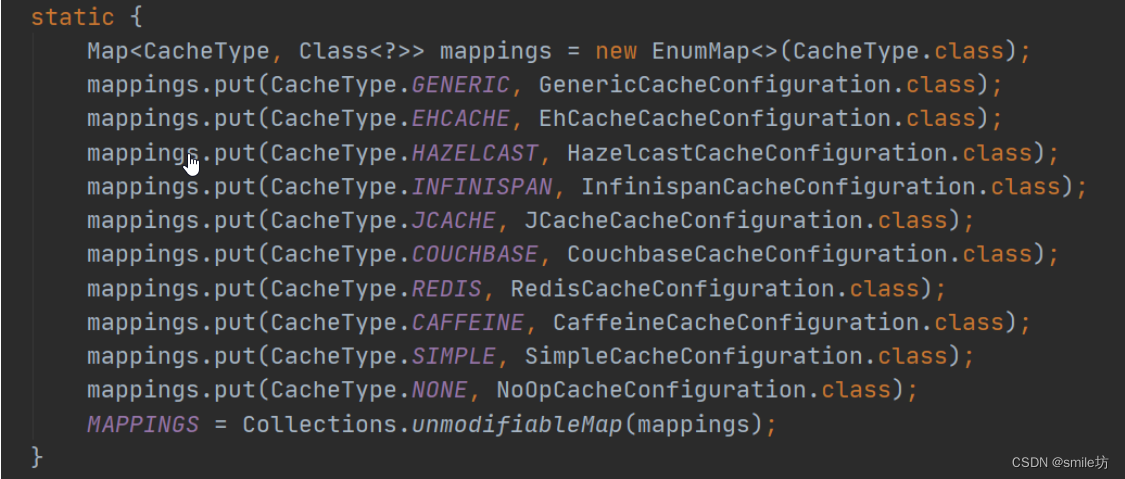Spring Cache的基本使用与分析
概述
使用 Spring Cache 可以极大的简化我们对数据的缓存,并且它封装了多种缓存,本文基于 redis 来说明。

基本使用
1、所需依赖
<dependency><groupId>org.springframework.boot</groupId><artifactId>spring-boot-starter-data-redis</artifactId>
</dependency>
<dependency><groupId>org.springframework.boot</groupId><artifactId>spring-boot-starter-cache</artifactId>
</dependency>2、配置文件
spring:# redis连接信息redis:host: 192.168.56.10port: 6379cache:# 指定使用的缓存类型type: redis# 过期时间redis:time-to-live: 3600000# 是否开启前缀,默认为trueuse-key-prefix: true# 键的前缀,如果不配置,默认就是缓存名cacheNameskey-prefix: CACHE_# 是否缓存空置,防止缓存穿透,默认为truecache-null-values: true3、Spring Cache 提供的注解如下,使用方法参见:官方文档,通过这些注解,我们可以方便的操作缓存数据。
@Cacheable:触发缓存写入的操作@CacheEvict:触发缓存删除的操作@CachePut:更新缓存,而不会影响方法的执行@Caching:重新组合要应用于一个方法的多个缓存操作,即对一个方法添加多个缓存操作@CacheConfig:在类级别共享一些与缓存有关的常见设置
例如,如果需要对返回结果进行缓存,直接在方法上标注 @Cacheable 注解(在主配置类上需要标注上 @EnableCaching)
@Cacheable(cacheNames = "userList") //指定缓存的名字,便于区分不同缓存
public List<User> getUserList() {...
} 4、redis 默认使用 jdk 序列化,需要我们配置序列化机制,自定义一个配置类,否则存入的数据显示乱码
@EnableCaching //开启缓存
@Configuration
public class MyCacheConfig {@Beanpublic RedisCacheConfiguration redisCacheConfiguration(){RedisCacheConfiguration config = RedisCacheConfiguration.defaultCacheConfig();//指定键和值的序列化机制config = config.serializeKeysWith(RedisSerializationContext.SerializationPair.fromSerializer(new StringRedisSerializer()));config = config.serializeValuesWith(RedisSerializationContext.SerializationPair.fromSerializer(new GenericJackson2JsonRedisSerializer()));return config;}
}5、使用以上配置后,虽然乱码的问题解决了,但配置文件又不生效了,比如过期时间等,这是因为在初始化时会判断用户是否自定义了配置文件,如果自定义了,原来的就不会生效,源码如下:
private org.springframework.data.redis.cache.RedisCacheConfigurationdetermineConfiguration(ClassLoader classLoader) {//如果配置了,就返回自定义的配置if (this.redisCacheConfiguration != null) {return this.redisCacheConfiguration;}//没配置使用默认的配置Redis redisProperties = this.cacheProperties.getRedis();org.springframework.data.redis.cache.RedisCacheConfiguration config = org.springframework.data.redis.cache.RedisCacheConfiguration.defaultCacheConfig();config = config.serializeValuesWith(SerializationPair.fromSerializer(new JdkSerializationRedisSerializer(classLoader)));if (redisProperties.getTimeToLive() != null) {config = config.entryTtl(redisProperties.getTimeToLive());}if (redisProperties.getKeyPrefix() != null) {config = config.prefixKeysWith(redisProperties.getKeyPrefix());}if (!redisProperties.isCacheNullValues()) {config = config.disableCachingNullValues();}if (!redisProperties.isUseKeyPrefix()) {config = config.disableKeyPrefix();}return config;
}6、所以,我们也需要手动获取 ttl、prefix 等属性,直接仿照源码就行,将配置类修改为如下:
@EnableCaching //开启缓存
@Configuration
@EnableConfigurationProperties(CacheProperties.class) //缓存的所有配置属性都在这个类里
public class MyCacheConfig {@Beanpublic RedisCacheConfiguration redisCacheConfiguration(CacheProperties cacheProperties) {//获取默认配置RedisCacheConfiguration config = RedisCacheConfiguration.defaultCacheConfig();//指定键和值的序列化机制config = config.serializeKeysWith(RedisSerializationContext.SerializationPair.fromSerializer(new StringRedisSerializer()));config = config.serializeValuesWith(RedisSerializationContext.SerializationPair.fromSerializer(new GenericJackson2JsonRedisSerializer()));//获取配置文件的配置CacheProperties.Redis redisProperties = cacheProperties.getRedis();if (redisProperties.getTimeToLive() != null) {config = config.entryTtl(redisProperties.getTimeToLive());}if (redisProperties.getKeyPrefix() != null) {config = config.prefixKeysWith(redisProperties.getKeyPrefix());}if (!redisProperties.isCacheNullValues()) {config = config.disableCachingNullValues();}if (!redisProperties.isUseKeyPrefix()) {config = config.disableKeyPrefix();}return config;}
}原理分析
在 Spring 中 CacheManager 负责创建管理 Cache,Cache 负责缓存的读写,因此使用 redis 作为缓存对应的就有 RedisCacheManager 和 RedisCache。
打开 RedisCache 源码,我们需要注意这两个方法:
1、读取数据,未加锁
@Override
protected Object lookup(Object key) {byte[] value = cacheWriter.get(name, createAndConvertCacheKey(key));if (value == null) {return null;}return deserializeCacheValue(value);
}2、读取数据,加锁,这是 RedisCache 中唯一一个同步方法
@Override
public synchronized <T> T get(Object key, Callable<T> valueLoader) {ValueWrapper result = get(key);if (result != null) {return (T) result.get();}T value = valueFromLoader(key, valueLoader);put(key, value);return value;
}通过打断点的方式可以知道 RedisCache 默认调用的是 lookup(),因此不能应对缓存击穿,如果有相关需求,可以这样配置:@Cacheable(sync = true),开启同步模式,此配置只在 @Cacheable 中才有。
总结
Spring Cache 对于读模式下缓存失效的解决方案:
- 缓存穿透:
cache-null-values: true,允许写入空值 - 缓存击穿:
@Cacheable(sync = true),加锁 - 缓存雪崩:
time-to-live:xxx,设置不同的过期时间
而对于写模式,Spring Cache 并没有相应处理,我们需要使用其它方式处理。
总的来说:
1、对于常规数据(读多写少,及时性、一致性要求不高的数据)完全可以使用 Spring Cache
2、对于特殊数据(比如要求高一致性)则需要特殊处理
